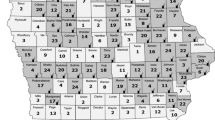Abstract
Managing highway rights-of-way (HROW) for safety depends upon the annual precipitation received and vegetation mowing practices. This study was conducted along a precipitation gradient in Texas, USA, to evaluate how precipitation and mowing treatments influence vegetation heights. The experiment was initiated in spring 1999 and completed in autumn 2002. Each site had ten treatments with four replications and consisted of forty 15 m × 6 m subplots. Commercial highway mowing equipment was used to mow the subplots at 5-, 10-, or 20-cm heights with an annual mowing frequency of one, two, or three times per year and a non-mowed control. A vegetation height of >30 cm is generally considered a safety hazard. Control subplot vegetation heights increased along the annual precipitation gradient. Most of the subplot vegetation heights at the more arid Andrews site (35 cm precipitation year−1) were <30 cm. Subplot vegetation heights at the Tahoka (50 cm precipitation year−1), Brady (66 cm precipitation year−1), and Lufkin (109 cm precipitation year−1) locations exceeded 30 cm, regardless of mowing frequency or height. Mowing treatments for HROW safety must be based on site-specific conditions. In areas that receive <35 cm precipitation year−1, mowing treatments have little effect on vegetation height, and management practices do not necessarily affect visual safety. In areas that receive >35 cm precipitation year−1, mowing three or less times per year, regardless of mowing height, makes it unfeasible to maintain the vegetation heights of <30 cm needed to maintain the HROW visual safety criterion.







Similar content being viewed by others
References
Borrelli J, McKenney C, Sosebee RE, Zartman RE (2003) Rights-of-way mowing height research (NTIS TX-0, 3/7-4903-2). Center for Multidisciplinary Research in Transportation, Texas Tech University, Lubbock
Craighead AC, Roberts EA, Craighead FL (2001) Bozeman Pass wildlife linkage and highway safety study. In: Proc int conf on ecology and transportation, Keystone, CO, USA, 24–28 Sept 2001
Dauber G (2008) Mowing for safety, safely (Tech Transfer Newsletter, Summer). Institute of Transportation Studies, University of California, Berkeley, p 10. http://www.techtransfer.berkeley.edu/newsletter/08-3/mowing-for-safety-safely.php
Delaware Department of Transportation (2005) Enhancing Delaware highways: roadside vegetation concept and planning manual. http://deldot.gov/information/pubs_forms/manuals/edh/index.shtml
Dishneau D (2009) Highway shoulders shaggy as states cut back mowing. http://www.saferoads.org/highway-shoulders-shaggy-states-cut-back-mowing
Finder RA, Roseberry JL, Woolf A (1999) Site and landscape conditions at white-tailed deer/vehicle collision locations in Illinois. Landsc Urban Plan 44:77–85
Hughes WE, Saremi AR, Paniati JF (1996) Vehicle-animal crashes: an increasing safety problem. Transpl Eng J 66(8):24–28
Iowa Department of Transportation (2008) Section 2612. Mowing. http://www.iowadot.gov/erl/archives/Oct_2008/GS/content/2612.htm
Johnson A (2000) Best practices handbook on roadside vegetation management manual 2000–2019. Minnesota Department of Transportation, Saint Paul
Kasperson J (2009) Less money, taller plants. http://www.erosioncontrol.com/july-august-2009/less-money-taller.aspx
Kentucky Transportation Cabinet (2008) Right of way mowing (052746). Kentucky Transportation Cabinet, Frankfort
Khattak AJ (2003) Human fatalities in animal-related highway crashes. Transp Res Rec 1840:158–166
Larkin TJ, Bomar GW (1983) Climatic atlas of Texas (LP-192). Texas Department of Water Resources, Austin
Levene H (1960) Robust tests for the equality of variances. In: Olkin I (ed) Contributions to probability and statistics. Stanford University Press, Palo Alto, pp 278–292
Lott GG, Graham P, Jr (1995) Florida landscape highway guide (WPI no. 10694; state project no. 99700-7105). Florida Department of Transportation, Tallahassee
Louisiana Department of Transportation and Development (2000) Policy for roadside vegetation management. http://www.dotd.la.gov/highways/maintenance/Policy_For_Roadside_Vegetation_Management.pdf
Mauchly JW (1940) Significance test for sphericity of a normal multivariate distribution. Ann Math Stat 11:204–209
Missouri Department of Transportation (2003) Roadside vegetation management. http://www.modot.org/services/documents/roadsidevegmgt5-03.pdf
Muratet A, Porcher E, Devictor V, Arnal G, Moret J, Wright S, Machon N (2008) Evaluation of floristic diversity in urban areas as a basis for habitat management. Appl Veg Sci 11:451–460
Mysterud A (2004) Temporal variation in the number of car-killed red deer Cervus elaphus in Norway. Wildl Biol 10(3):203–211
National Climatic Data Center (2002) Climatological data: Texas, vol 107, no. 13. National Climatic Data Center, NOAA, Ashville, ISSN 0364-6041
Nebraska Department of Roads (2009) Highway mowing guidelines. http://www.dor.state.ne.us/docs/weeds/HwyMowing.pdf
Nofal H, Sosebee RE, Wan C, Borrelli J, Zartman R, McKenney C (2004) Mowing rights-of-way affects carbohydrate reserves and tiller development. J Range Manage 57:497–520
Northcutt P (2002) Mowing tips for roadsides. http://www.teex.org/eu/documents/02_07-09.pdf
Ohio Turnpike Commission (2003) Modification of the OTC’s mowing program. http://www.ohioturnpike.org/media/pdf/stormwaterprogram_mowing_article.pdf
Parr TW, Way JM (1988) Management of roadside vegetation: the long-term effects of cutting. J Appl Ecol 25:1073–1087
Ramp D, Caldwell J, Edwards KA, Warton D, Croft DB (2005) Modeling of wildlife fatality hotspots along the snowy mountain highway in New South Wales, Australia. Biol Conserv 126(4):474–490
Rea RV (2003) Modifying roadside vegetation management practices to reduce vehicular collisions with moose Alces alces. Wildl Biol 9(2):81–91
Rowden P, Steinhardt D, Sheehan M (2008) Road crashes involving animals in Australia. Accid Anal Prev 40(6):1865–1871
Shapiro SS, Wilk MB (1965) An analysis of variance test for normality (complete samples). Biometrika 52:591–611
Tasser E, Tappeiner U (2002) Impact of land use changes on mountain vegetation. Appl Veg Sci 5:173–184
Tyser RW, Worley CA (1992) Alien flora in grasslands adjacent to road and trail corridors in Glacier National Park, Montana (USA). Conserv Biol 6:253–262
Underwood CV (1969) Management of verges. In: Road verges: their function and management. Monks Wood Experimental Station, London
U.S. Department of Transportation [USDOT], Federal Highway Administration (2004) The nature of roadsides and the tools to work with it (publ. no. FHWA-EP-03-005 HEPN-30). U.S. Department of Transportation, Washington
Author information
Authors and Affiliations
Corresponding author
Rights and permissions
About this article
Cite this article
Zartman, R.E., McKenney, C.B., Wester, D.B. et al. Precipitation and mowing effects on highway rights-of-way vegetation height and safety. Landscape Ecol Eng 9, 121–129 (2013). https://doi.org/10.1007/s11355-011-0184-x
Received:
Revised:
Accepted:
Published:
Issue Date:
DOI: https://doi.org/10.1007/s11355-011-0184-x




